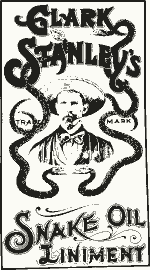
Cures all that ails!!
Unless you live in a sensory deprivation chamber, you know that we’re awash in news stories and advertisements for food products, drugs, pain remedy potions, supplements of various sorts and all kinds of fitness and health fads. White-lab coated doctors appear on popular TV shows extolling the virtues of antioxidants, fiber, raw foods ionized bracelets, colonic cleanses and more.
We’re often told these products are “clinically proven” or that “Studies show” huge life-changing success when we use these products. But what do these terms mean? Are the hard-to-believe claims possibly true? Which if any of these “sciencey” sounding products are worthwhile, effective or even safe? I’m not a scientist, so what should I believe? (I should add that I’ve probably been convinced more than a few times of the worth of some worthless things.)
In an effort to understand some of this stuff, I’m reading Ben Goldacre’s Bad Science, and I’m learning a lot. He discusses in clear terms some of the strange claims made by practitioners of complimentary alternative medicine (CAM) such as homeopaths and nutritional gurus. We learn about the extraordinarily powerful placebo effect and why this effect is often at the core of alternative treatment methods. We get an in-depth look at the shocking and strange situation surrounding the recent HIV/AIDS denial controversy in South Africa. (This was the conflict in which South African president Thabo Mbeki and his cohorts fully ignored all scientific data regarding treatment and prevention of HIV/AIDS. The result was many thousands of premature deaths due to denial of antiretroviral drugs to HIV/AIDS patients in that country. One man, Mathias Rath, a German vitamin pill peddler, profited tremendously from this situation.) Goldacre also takes the pharmaceutical industry to task for various dubious, dangerous practices and manipulation of data. Bad Science is a look inside all sorts of snake oil.
Thus far I’ve found the chapter on nutritionists particularly interesting. We get some history of nutritional quackery. We learn about a man named John Harvey Kellog. You may recognize his last name. He helped create the cornflake. He sold granola bars, ran a sanatorium where patients were treated with “holistic methods,” advocated colonic cleansing which is popular today (By the way, that’s putting stuff in through a very clearly marked exit.), and he campaigned vigorously against masturbation. (He had some particularly stringent views on incorporating pain into circumcision as a way of inhibiting the enjoyment of sex in boys, and he advocated using carbolic acid on the clitoris to similarly dissuade sexual excitement in girls.)
What you start to realize is that ALL this stuff has been around for a long time. Charlatans making outrageous “sciencey” claims have been with us for decades if not centuries. They claim in one breath that cutting edge science is on their side. Yet when their methods and practices are subjected to truly rigorous scrutiny–and their methods are shot full of big holes–they huff and puff (sometimes they sue) and insist that the medical community is against them. Beware of these people. A lot of them–guys like Dr. Oz, Andrew Weil, Deepak Chopra–are very popular and highly respected in some circles including the popular press. They’re entertaining and they deliver very interesting messages. They also run in quite another direction from much of mainstream science.
If we’re looking to summarize the differences between CAM and conventional medicine, the following statement from the site Quackwatch.com says it best:
“Until now, alternative medicine has generally been rejected by medical scientists and educators, and by most practicing physicians. The reasons are many, but the most important reason is the difference in mentality between the alternative practitioners and the medical establishment. The leaders of the establishment believe in the scientific method, and in the rule of evidence, and in the laws of physics, chemistry, and biology upon which the modern view of nature is based. Alternative practitioners either do not seem to care about science or explicitly reject its premises. Their methods are often based on notions totally at odds with science, common sense, and modern conceptions of the structure and the function of the human body. In advancing their claims, they do not appear to recognize the need for objective evidence, asserting that the intuitions and the personal beliefs of patients and healers are all that is needed to validate their methods.”
One statement I found resonated with me, and I think it will help me keep a proper perspective. “There’s a word for alternative medicine that holds up to scientific scrutiny: Medicine.”
Goldacre doesn’t spend all his time bashing CAM, just most of his time. Early in the book he discusses one area where many CAM practitioners outdo their conventional medical counterparts and that’s in listening to the patient. A huge part of a patient’s feeling better relies on the doctor/patient relationship–the doctor’s bedside manner. Many of us have experienced a doctor’s appointment in which we’re rushed through, talked down to, not listened to, and the doc doesn’t do a good job of explaining what’s happening. This does not help us feel better. In contrast, much of the benefit of CAM may lie in the experience of someone taking time to genuinely listen to us, thus calming us and giving us hope that we can feel better.
Bad Science is a fun, snarky read. Goldacre’s criticism of the CAM industry is very direct. At times he’s sarcastic and creatively belittling of alternative medicine. If you’re an advocate of CAM then you might get a little worked up and defensive. If you’re interested in getting a deeper understanding of all the confusing medical and pseudo-medical information around us, please get a copy of Bad Science. You don’t have to be a scientist to understand what Goldacre is saying. For more fun and good information, have a look at Goldacre’s site BadScience.net.

